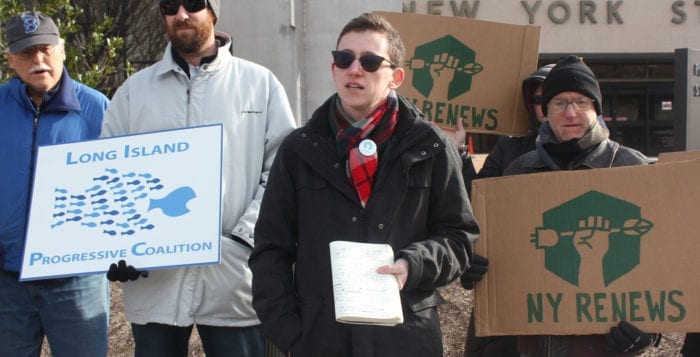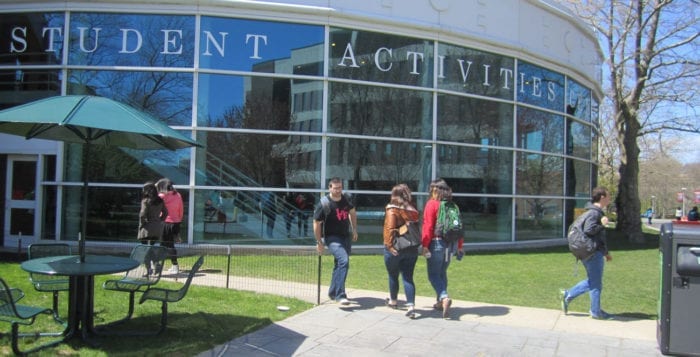By Kevin Redding
In the wake of the decision of President-elect Donald Trump (R) to nominate ExxonMobil CEO Rex Tillerson as secretary of state, along with climate-change doubters to top federal positions, Long Island residents and economy activist groups called on Gov. Andrew Cuomo (D) to #TakeTrumpOn and fight against the climate-change denial of the incoming administration.
Holding up signs reading “NY Renews” and “Make NY A Climate Leader,” the group of protesters rallied in front of the New York State Department of Motor Vehicles Office in Hauppauge Dec. 21, urging Cuomo to move the state and country forward and pass the Climate and Community Protection Act in his upcoming 2017 state budget.
The act would attempt to mitigate the adverse effects of climate change through a combination of measures aimed at reducing statewide greenhouse gas emissions and improving the state’s resiliency against future extreme weather events, like Hurricane Sandy.
Long Island Progressive Coalition member K.C. Alvey said, at the protest, that climate change needs to be acknowledged.
“Climate change is real, it’s urgent, and our communities are already being impacted by climate disasters,” she said. “We need to be dealing with this now and rapidly transitioning to a clean-energy economy that works for all of us.”
“If you don’t believe there’s global warming, just wait until the next full moon high tide and try to drive along the South Shore of Long Island. You can’t do it. It’s flooded.”
— Jack Finkenberg
Alvey said Cuomo has expressed his support for many of these environmental policies. In August, the governor announced the approval of New York’s Clean Energy Standard, which requires 50 percent of the state’s electricity to come from renewable energy sources like wind and solar by 2030, with a phase-in schedule throughout the next several years.
“We need him to codify this into law and move these plans forward,” Alvey said. “We’re not just calling for clean energy by any means necessary … we’re calling for a just and equitable transition to 100 percent clean energy and making sure that no one is left behind.”
During the course of his campaign and since winning the election, Trump has voiced his skepticism of the scientific view that humans cause global warming.
The president-elect has tweeted out “the concept of global warming was created by and for the Chinese” in order to topple the United States in manufacturing, and he has expressed interest in canceling the Paris climate accord and undoing clean air and water protections. This potential action has caused distress among scientists and climate activists.
Shay O’Reilly, an organizer with the not-for-profit Sierra Club, called the Trump administration “a set of billionaires who seek to further enrich themselves and defend what they have already accumulated by reinforcing our present reliance on fossil fuels.”
O’Reilly said the new cabinet and their beliefs threaten the immediate survival of marginalized colonies from New York to the South Pacific, but especially Long Island — a uniquely vulnerable location to climate change, with so much coastline.
O’Reilly said what’s done in New York can affect the rest of the country and the world, should it be decided to pass the legislation.
“State action on climate change is not just a political necessity, but a moral imperative,” O’Reilly said. “Cuomo needs to lead the way and listen to the people of New York.”
Jack Finkenberg, from the New York Communities for Change coalition, said there are real examples of global warming all over the world.
“If you don’t believe there’s global warming, just wait until the next full moon high tide and try to drive along the South Shore of Long Island,” he said. “You can’t do it. It’s flooded. We need to protect our communities, healthwise, with the rising rates of skin cancer and respiratory disease. Global warming is a serious thing and it’s got to stop.”
Alvey ended the protest by leading the group in a call-and-response chant.
“What do we want?” she yelled. “Renewable energy,” the protesters shouted back.
“When do we want it?” she asked. “Now,” they answered.






